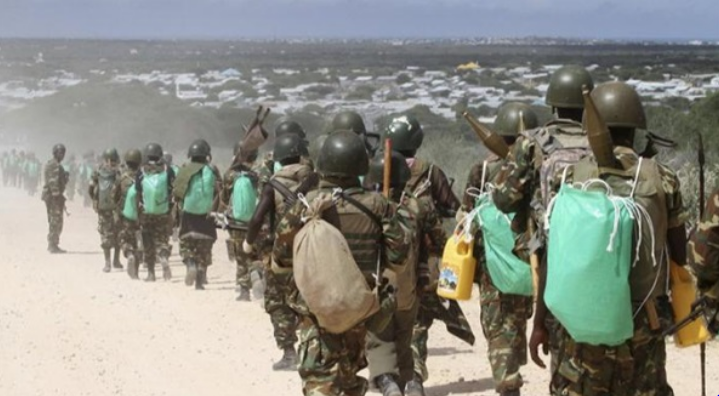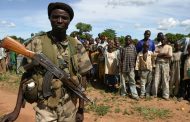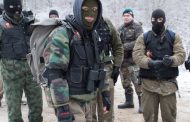Mustafa Kamel
An ambiguous future surrounds Somalia in light of the withdrawal of international forces from its war against the terrorist Al-Shabaab movement, which began to chart the way for it by preparing a new generation carrying its extremist ideas by imposing extremist educational curricula in some of the areas it controls in Somalia. There is also the fear of a repeat of the Taliban model in Afghanistan, where the extremist movement took control of the reins of government, reinforcing terrorism and al-Qaeda’s presence in the country that has witnessed increasing terrorism since the beginning of the millennium, as Al-Shabaab could attempt to control the neighboring African countries to control the Horn of Africa and relocate the leadership there.
Beginning
The emergence of Al-Shabaab began in 2006 as one of the military arms of what was known at the time as the Islamic Courts Union in Somalia, which at that time controlled the capital, Mogadishu, and sought to establish a so-called Islamic caliphate. At the beginning, the movement supported the Islamic Courts Union as it fought battles against government forces backed by Ethiopian forces, which were forced to withdraw at the end of 2008, and it also had a close association with al-Qaeda since 2009 and officially declared its allegiance to it in 2012 in a video tape broadcast by the movement.
At the beginning of its establishment, the network included current and former members of al-Qaeda in East Africa, as veterans of Afghanistan enjoyed privileges within the movement based on their clear relationships with al-Qaeda. By the beginning of 2005, the movement had strengthened as an organization and participated in campaigns to control Mogadishu at that time, which was known as “the specter of war in Mogadishu,” and the movement supported the Sharia courts against the military leaders.
Al-Shabaab succeeded in strengthening its position and influence within the Islamic Sharia court system, occupied the position of prosecution leadership in the Sharia courts army, collected donations among the Somali diaspora, and assumed responsibilities in health activities and youth work within the coalition. But with the entry of the Ethiopian forces at the end of 2006 and the defeat of the authority of the courts in Mogadishu, the movement took a strong opportunity to prove its existence and justifications for imposing its terrorist agenda, as it provided sufficient justification to take up arms and use them in the face of the Ethiopian aggression.
The movement separated from the rest of the Sharia courts by mid-2007, stating through the media that it was no longer fighting as a resistance, but rather that it was waging an armed jihad against what it called the Ethiopian aggression. This contradicted the alliances that the Sharia courts had made, and at that time Ahmed Abdi Godane assumed the leadership of the movement.
The Somali movement includes in its ranks between five to nine thousand fighters, according to Le Monde sources, including Somalis and about 800 foreign fighters, most of whom came from Arab countries in addition to Pakistan. In September 2014, Ahmed Umar Abu Ubaidah became the leader of the movement after the death of Godane, who was killed in a US air strike. In the same year, the movement renewed its allegiance to al-Qaeda leader Ayman al-Zawahiri.
Constant struggle
The internal turmoil in Somalia has contributed to giving terrorist groups, most notably Al-Shabaab, opportunities to increase their influence towards achieving their goal of establishing an alleged state in the Horn of Africa that threatens the security of eastern Africa and imposes their own ideological and political restrictions on the citizens of the region.
There are many dangers from Al-Shabaab in the region in terms of carrying out continuous terrorist operations against important security and tourism points in Somalia, in addition to threatening navigation and fishing operations in the Horn of Africa and carrying out attacks against neighboring countries, most notably Kenya.
Al-Shabaab is exploiting its influence in the region to attack military bases in Somalia and Kenya, in addition to exploiting the political dispute with ISIS to carry out attacks in separate areas of the country, where each of them carried out many bombings and terrorist operations against civilians and military personnel.
The group is also exploiting Somalia’s wealth for economic and political gain, as the United Nations reported that the movement profited from high-quality charcoal in Somalia. The year 2021 was full of terrorist operations launched by the terrorist movement, the most prominent of which was targeting the economy, including the navigation economy and investments related to water bodies, such as harbors and fishing fleets. This means that it threatens large and small resources, whether state investments or the investments of small workers, as hotels and tourist areas represent a dangerous destination for Al-Shabaab attacks in the region.
In December, after the departure of Somali government forces, Al-Shabaab launched more terrorist operations in order to control the largest possible amount of Somali territory, especially in Galmudug state, in the absence of any official response from the Somali government.
Reuters quoted an official from the Somali army as saying that Al-Shabaab, which took control of a town 30 kilometers south of Dusmareb, the capital of Galmudug, also bombed a police station before seizing the town. The forces of Galmudug state left the town, and the movement imposed its control over it.
Regarding the terrorist escalation of the movement, Al-Shabaab is witnessing a development in structure and tactics, so it has moved from an armed group in Somalia to a terrorist movement affiliated with al-Qaeda, and it has managed to extend its control over half of the territory of Somalia, where it seeks to rule through its attempts to obstruct the Somali elections, especially with the terror it spreads in the hearts of Somalis by warning them not to participate in the elections. The spokesman for the movement issued a direct warning, describing the Somalis as “infidels” if they participated in the elections, revealing that the targeting of tribal elders was for their participation in the formation of the previous government.
With the support of al-Qaeda, Al-Shabaab has obtained states that had been without the movement more than 10 years ago, serving as evidence that the movement is benefiting from deepening political divisions in Somalia ahead of the long-postponed presidential elections scheduled to take place next year. The incursions emerged in the wake of infighting between the Somali government and its former allies of the Ahl al-Sunnah Wal Jama’a, a militia in Galmudug that played a key role in the fight against al-Shabaab, while the group says that this government allowed many militants to get close to it.
International forces
As part of the international efforts to eliminate Al-Shabaab in Somalia, Britain announced its participation in the war against the movement by sending troops for training to Somalia, stressing that the step will take place during the next year. The newspaper New Somalia reported in the middle of 2021 that Britain will participate with 250 soldiers, and this comes just months after the announcement of the establishment of the Special Operations Brigade by the former commander of the Special Air Service, General Sir Mark Carleton-Smith, who currently heads the British Army.
The British government announced the completion of the training of 500 Somali soldiers in the form of five batches, the last of which consisted of 113 soldiers, who graduated on December 31, 2020. According to an official statement published by the British government, the Somali soldiers were trained in basic infantry skills to fight armed groups, as the exercises included marksmanship, patrols, medical assistance and counter-IED techniques provided by a military team of 26 officers of the British Royal armed forces.
In addition to the British presence, US moves have emerged in the country, as senior officials in the administration of US President Joe Biden visited Somalia last week, while the White House said that the goal is to strengthen the war against al-Shabaab.
According to a statement issued by the White House, the visit focused on advancing the Biden administration’s counterterrorism policy in an evolving threat landscape, prioritizing the most dangerous and growing threats, empowering local partners to prevent and combat terrorist threats within their borders, and working multilaterally with allies and regional and international partners.
In addition, eleven soldiers serving under the African Union Mission in Somalia (AMISOM) concluded a training course on the mechanisms of operating drones, which are important for modern military operations. The United Nations Support Office in Somalia and AMISOM facilitated a two-week training workshop in Mogadishu in cooperation with trainers from the United Nations Field Technology Services, as well as the use of small unmanned aircraft equipped with an infrared imaging system in convoys, foot patrols, surveillance, search and rescue operations, and battlefield assessments.
Failed mission
On the other hand, the report of the African Institute for Security Studies (ISS) stated in a study that the AMISOM forces are scheduled to withdraw on December 31, heralding the return of Al-Shabaab, which is increasingly penetrating state institutions, including security, taking advantage of the tribal nature of society.
AMISOM’s mission is to combat the insurgency of the terrorist movement and to strengthen the government forces. It includes a force of more than 19,000 soldiers and 1,000 policemen. However, it did not achieve all its goals, in a repetition of what happened in Afghanistan and Mali, where neither the US nor the French forces succeeded in eliminating terrorism and extremism in the two countries.
As for the future of AMISOM, which was surrounded by failure, the ISS report stated that it presented five options that were included in the recommendations of the United Nations and the African Union on the future of the AMISOM mission, most notably the departure of AMISOM and the transfer of its responsibilities to the Somali security forces, and the replacement of the mission with the reserve force for East Africa. The United Nations called it a “special regional alliance,” but this advice is not effective, because all the troop contributors to the mission are from East Africa. The third option is the replacement of the AMISOM mission with a stabilization mission led by the United Nations, and the fourth is the replacement of the mission with a hybrid operation between the African Union and the United Nations, in addition to reducing the number of the mission while enabling the Somali security forces to assume responsibility.
Fear of Afghan scenario
At a time when AMISOM insists on a complete withdrawal from Somalia, which portends great danger, its withdrawal is expected to repeat the Afghan scenario in the country. In the event of any random withdrawal of AMISOM forces, the fate of Somalia will not be better than the fate of Afghanistan in terms of the country falling into the grip of terrorist organizations with the collapse of the legitimate government.
According to what was monitored by security and political reports, the international forces in the three countries did not achieve their desired goal, which is to end terrorism and re-establish the control of government forces over all the country’s lands.
Kate Foster, Britain’s ambassador to Somalia, indicated that there are fears of a similar occurrence as to what happened in Afghanistan if African forces withdraw from Somalia.
“I think the situation in Afghanistan is something that the Somalis talked about this week, and there are lessons to be learned. The situation in Afghanistan is similar to the situation in Somalia. I assure people that there is no immediate plan for the withdrawal of AMISOM, but the United Nations Security Council decided that the security command must be handed over to the Somali forces in an orderly manner,” she said.
Foster explained that the Somali government and the African Union are in talks to implement the plan for AMISOM to hand over tasks to the Somali security services, which will eventually include providing advice and training to the Somali security forces.
Ambiguous future
Somalia is surrounded by an ambiguous future due to the presence of the terrorist movement and the withdrawal of AMISOM forces from there. Al-Shabaab seeks to impose extremist educational curricula in some of the areas they control in Somalia, in the context of spreading tainted ideas that threaten the coming generations of children.
According to a report issued by the New Somalia website in August, it confirmed that the Al-Shabaab is trying to impose curricula that it has prepared to carry its extremist ideology, including all primary, preparatory and secondary levels in schools in Mogadishu, where the movement summoned the principals of some of the major schools in the capital to discuss the issue, and orders were issued to adopt the new curriculum prepared by the movement.
According to the report, the matter may actually cause school officials to find themselves facing militia threats if these orders are not implemented, since they cannot accept this in the capital, which is under the control of the Somali government.








































admin in: How the Muslim Brotherhood betrayed Saudi Arabia?
Great article with insight ...
https://www.viagrapascherfr.com/achat-sildenafil-pfizer-tarif/ in: Cross-region cooperation between anti-terrorism agencies needed
Hello there, just became aware of your blog through Google, and found ...